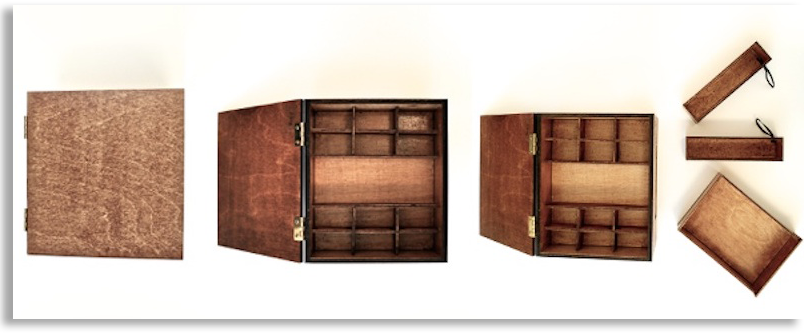Fluxkits
Fluxkits for scholarly communication (aka kits for cultural history) are perhaps best understood as small boxes of inexpensive materials assembled for the purposes of media history. They were central to work we performed in the MLab during the 2010s, and they were inspired by Fluxkits made during the 1960s and ’70s by George Maciunas, Ay-O, George Brecht, Dick Higgins, Alice Hutchins, Alison Knowles, Carla Liss, Larry Miller, Nam June Paik, Mieko Shiomi, Yoshimasa Wada, Robert Watts, and other Fluxists.
The idea was to integrate the activity of construction, the practice of conjecture, and a range of sensory experiences into the conventions of the academic article, particularly articles about the inaccessible stuff of history. Drawing from the lab’s electro-mobile jewelry project, I published a rationale for the kits’ design and use in comparative media studies. I wrote that rationale in essay form but included with it some images, video, and files produced by other MLab researchers. The open access journal, Hyperrhiz: New Media Cultures, published it all in 2015.
Links to the Hyperrhiz piece as well as corresponding images, video, files, and research are below. I included an abstract, too, and point to some related talks I gave at Union College (2015), Cornell (2016), Washington State University (2016), and HASTAC (2016). Thanks to Nina Belojevic, Tiffany Chan, Nicole Clouston, Katherine Goertz, Shaun Macpherson, Kaitlynn McQueston, Danielle Morgan, and Victoria Murawski for conducting this research with me in the MLab. Thanks as well to Robert A. Emmons, Jr. and James J. Brown, Jr. for curating the exhibition at Rutgers where this work was first shown, and to Helen J. Burgess and David M. Rieder for providing a peer-reviewed venue for it.

Kits for Cultural History, or Fluxkits for Scholarly Communication
Published in Hyperrhiz: New Media Cultures 13 (Rieder, Emmons, Jr., Brown, Jr., and Burgess, eds.) in Fall 2015 | 4126 words, with photographs, video, and files by Nina Belojevic, Tiffany Chan, Nicole Clouston, Katherine Goertz, Shaun Macpherson, Kaitlynn McQueston, Danielle Morgan, and Victoria Murawski | open access
Links: article (HTML); photographs (ZIP); video (MP4); repository (GitHub); MLab research on kits for cultural history (HTML); exhibition at Rutgers (HTML); talks at Union College, Cornell, WSU, and HASTAC (HTML); resources related to “Types of Prototypes”, “Critical Design”, and “Reading Media in Theory” (HTML)
A project at the University of Victoria’s Maker Lab in the Humanities, the Kits for Cultural History (“Kits”) are small boxes of inexpensive materials assembled for media history. Building on the intermedia legacies of Fluxkits, they emphasize the importance of everyday experience and tacit knowledge to remembering the past. Research for the Kits focuses on technologies that are inaccessible in today’s galleries, libraries, archives, and museums. This research complicates histories framed by screens and expressed in books, asks what is missing from both, and then prototypes the absences for circulation and critique. Through this process, design becomes inquiry.
From a design perspective, the Kits ask how technologies are culturally embedded, and how meaning is entangled with matter, through a sort of accidental theory: instead of starting with a program, supporting it, and ultimately proving it, the Kits present a collection of positions and parts for material investigation, which then prompts participants to attend to specific issues at the intersections of politics and aesthetics. The Kits also bypass appeals to “real history” and “exact replicas” by versioning the past. They variously articulate components to demonstrate how technologies are constructed, replete with editorial decisions, scripted with values, and subject to change and alteration over time. Ultimately, this process declares that the history at hand is incomplete, yet it also uses three-dimensional media and computer numerical control (CNC) techniques to rethink how scholarly communication happens.
Featured image and photograph of the box for the MLab’s early wearables kit care of Nina Belojevic, Tiffany Chan, Nicole Clouston, Katherine Goertz, Shaun Macpherson, Kaitlynn McQueston, Danielle Morgan, Victoria Murawski, and me. Both used with permission. I created this page on 24 July 2019 and last updated it on 30 January 2022.